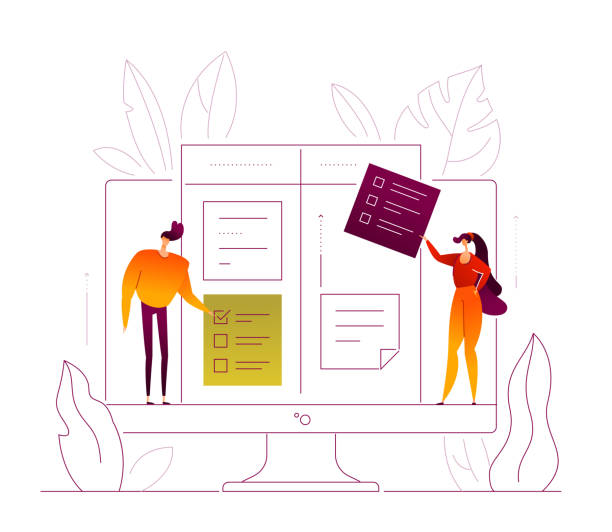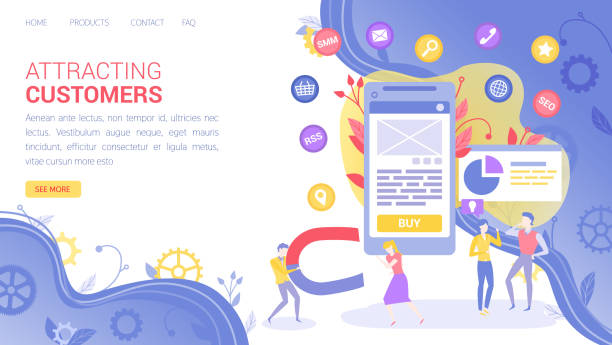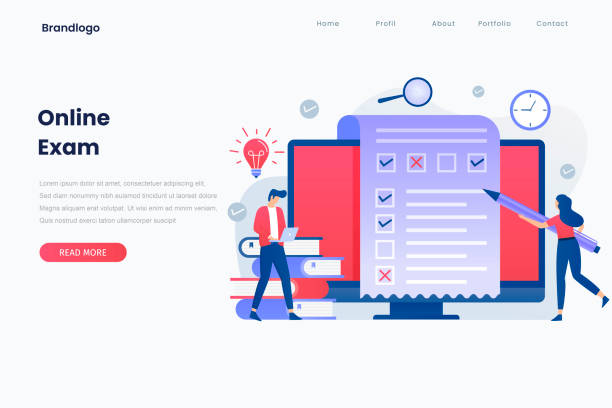The Paramount Importance of Secure Website Design in the Digital Age

In today’s world, where the internet has become an inseparable part of our lives, secure website design is no longer a luxury, but a vital necessity.
#Website_security, #user_data_protection, and #online_trust are three main pillars that every business or individual must pay special attention to.
Without a secure digital platform, there is a risk of losing sensitive data, damaging reputation, and even extensive financial losses.
In this regard, the importance of cybersecurity in website design is clearly evident, as cyberattacks are becoming more complex and targeted day by day.
Ensuring the safety of customer data and protecting their privacy is one of the most important duties of every web developer. This issue is not only beneficial for users but also crucial for the long-term sustainability and success of any online business.
Imagine having a website that is attacked due to a failure to adhere to the principles of secure website design; the consequences could be beyond imagination and destroy user trust forever.
Therefore, the first step in creating any online platform should be a deep and serious focus on its security aspects.
Did you know that a weak corporate website costs you many opportunities daily? Solve this problem forever with professional corporate website design by Rasawp!
✅ Create a powerful and reliable image for your brand
✅ Targeted attraction of new customers and increased sales
⚡ [Get free website design consultation]
Common Web Security Threats and How to Identify Them

Knowing the enemy is half the battle.
In the field of secure website design, this means we must be familiar with common security threats to prevent them.
#SQL_Injection_attacks, #Cross_Site_Scripting_(XSS), #DDoS, and #data_breaches are among the most dangerous attacks threatening websites.
Did you know that many of these attacks can be exploited through simple weaknesses in coding or server configurations? For example, in an SQL Injection attack, the attacker tries to gain access to your database by injecting malicious code into input forms.
This can lead to the theft, modification, or even complete deletion of data.
OWASP Top 10 provides a comprehensive list of the most critical web vulnerabilities, and studying it is essential for every developer.
Regular analysis of security reports and reviewing server logs can help identify suspicious patterns and intrusion attempts. Early identification of these threats before they lead to serious damage is a crucial step in maintaining your secure website design.
This analytical section helps us gain a comprehensive view of the challenges and methods to counter them.
Fundamental Principles in Secure Website Design from the Ground Up

To create a secure website design, fundamental security principles must be observed from the very initial stages of development.
#Security_by_Design, #Principle_of_Least_Privilege, and #Input_Validation are three key principles that every developer must adhere to.
Security by Design means that security must be considered from the planning and system architecture phase, not added as a separate component at the end of the project.
This approach ensures that all aspects of the system are developed with security in mind.
The Principle of Least Privilege states that every user, service, or application should only be equipped with the minimum necessary access to perform its tasks, no more.
This minimizes the risk of abuse of unnecessary access.
Input validation is one of the most crucial mechanisms to prevent attacks such as SQL Injection and XSS. Any data received from users must be carefully validated and filtered to prevent the entry of malicious code or invalid data.
For example, user inputs should never be directly placed into database queries; Prepared Statements or ORMs should always be used.
These principles are the backbone of any secure and attack-resistant website, and adhering to them is of high importance for secure website design.
Securing the Back-End (Server and Database) in Secure Website Design

The Back-End is the heart of every website, and securing it is essential for secure website design.
#Server_security_configurations, #database_security, and #API_management are aspects that must be carefully reviewed.
Your web server (such as Apache or Nginx) must be configured with only the essential services and the latest security patches.
Disabling unnecessary ports and using strong firewalls (such as Web Application Firewalls (WAFs)) can provide additional layers of defense.
Regarding the database, encrypting sensitive data, using strong and unique passwords for each database user, and restricting access are of particular importance.
Apart from these, all communications between the server and the database must be encrypted.
Furthermore, using hash functions to store passwords instead of plain text and adding salt to the hashes significantly increases the security of user accounts. API management must also be done carefully; proper authentication for API requests and rate limiting to prevent Brute-Force attacks are essential.
To demonstrate the importance of security measures in this section, please refer to the table below:
| Area | Security Measure | Description |
|---|---|---|
| Server | Regular Updates and Patching | Installing the latest operating system and server software updates to address vulnerabilities. |
| Server | Firewall Configuration | Blocking unnecessary ports and restricting access to server services. |
| Database | Sensitive Data Encryption | Encrypting user, financial, and other confidential data in the database. |
| Database | Granular Access Management | Granting minimum necessary access to users and applications to the database. |
| API | Strong Authentication | Using tokens, API keys, and OAuth to verify the identity of API requestors. |
| API | Rate Limiting | Limiting the number of requests a user or IP can send within a specified timeframe. |
These are foundational measures that help you achieve a strong and secure website design.
Do you dream of a thriving online store but don’t know where to start?
Rasawp is your comprehensive e-commerce website design solution.
✅ Attractive and user-friendly design
✅ Increased sales and revenue⚡ Get free consultation
Protecting the Front-End and Secure User Experience in Secure Website Design
![]()
Alongside the Back-End, protecting the Front-End is also very important for secure website design.
#Cross_Site_Scripting_(XSS), #Cross_Site_Request_Forgery_(CSRF), and #cookie_management are among the common vulnerabilities in this section that must be addressed.
XSS allows attackers to inject malicious client-side scripts into your pages, which can lead to the theft of cookies or session information.
To prevent it, user inputs should always be escaped or sanitized before being displayed on the page.
CSRF also allows an attacker to force a user to perform actions they did not intend, such as changing a password.
Using CSRF tokens in forms is an effective way to combat these attacks.
Proper cookie management, especially using HttpOnly and Secure flags, can prevent malicious scripts from accessing sensitive cookies. HttpOnly makes cookies inaccessible to JavaScript code, and Secure ensures that the cookie is only sent over an HTTPS connection.
Educating users to identify suspicious links and informing them about the importance of using strong passwords are also guiding measures to enhance Front-End security.
A secure website design covers both Front-End and Back-End sections.
Strong Authentication and Authorization in Secure Website Design

Authentication and Authorization are the main pillars of security in secure website design.
#Strong_passwords, #Two-Factor_Authentication_(2FA), and #session_management are among the key topics in this area.
Strong, long passwords combining uppercase and lowercase letters, numbers, and symbols are the first line of defense against unauthorized access.
Developers should encourage users to create such passwords and avoid storing passwords in plain text; instead, strong hash functions with Salt should be used.
Two-Factor Authentication (2FA) provides an additional layer of security, requiring the user to have a second factor (such as an SMS code or an authenticator app) for login, in addition to the password.
This method prevents attackers from breaching even if the password is compromised.
Proper session management is also very important; sessions should expire after a specified period, and session tokens should be invalidated after the user logs out to prevent Session Hijacking attacks. Furthermore, using secure session cookies with Secure and HttpOnly flags is essential.
These explanatory measures help ensure that only authorized users can access relevant resources and prevent intrusion and misuse, which is vital for any secure website design.
The Importance of Continuous Updates and Security Maintenance

Security is a continuous process, not a one-time event.
In the field of secure website design, #software_updates, #security_patches, and #data_backups are of vital importance.
Attackers are constantly looking for new vulnerabilities in common software (such as operating systems, frameworks, libraries, and plugins).
Therefore, installing updates and security patches released by manufacturers immediately upon their availability prevents potential intrusions. Neglecting this can make your website vulnerable to known attacks.
Regular and automatic data backups are also a proactive security measure that allows you to restore data and minimize downtime in the event of any disaster (such as a successful cyberattack or human error).
These backups should be stored in secure and separate locations.
These are not news items, but operational routines that every online business must commit to ensure the stability and security of its website.
A proactive approach to security maintenance is the cornerstone of a long-term secure website design.
To better understand the importance of these measures, please refer to the security maintenance table below:
| Activity | Frequency | Importance |
|---|---|---|
| Server OS Updates | Monthly / Upon critical patch release | Very High: Addresses foundational vulnerabilities. |
| Framework and Library Updates | Quarterly / Upon critical patch release | High: Prevents software vulnerability-based attacks. |
| Plugin and Module Review | Monthly / Before new installation | Medium to High: Ensures no malicious code or vulnerabilities. |
| Full Database Backup | Daily / Weekly | Very High: Data recovery in case of disaster. |
| Website File Backup | Weekly / Monthly | High: Website structure and content recovery. |
| Security Log Review | Daily / Weekly | Medium to High: Early detection of intrusion attempts. |
| Penetration Testing | Annually / After major changes | Very High: Real assessment of attack resistance. |
Responding to Security Incidents and Data Recovery

Even with the best approaches to secure website design, the probability of security incidents is not entirely zero.
#Incident_response_planning, #Disaster_Recovery, and #post-incident_analysis are vital elements for any website.
Having a predefined incident response plan helps your team react quickly and effectively when an attack occurs.
This plan should include stages of identification, containment, eradication, recovery, and post-incident analysis.
Speed in responding to a breach can be the difference between a minor incident and a major catastrophe. Disaster Recovery refers to a set of processes and policies that enable the restoration of systems and data after a destructive event.
This section includes backup strategies, alternative storage locations, and recovery procedures.
After each incident, a thorough analysis of what happened, why it happened, and how to prevent its recurrence in the future, is crucial.
These learnings help you make your systems more resilient in the future.
This analytical section shows us that even after a breach, with proper preparation and planning, damage can be minimized, and the website can be quickly restored to normal operation.
A smart secure website design also has a plan for worst-case scenarios.
Are you tired of losing business opportunities due to not having a professional corporate website?
Rasawp helps you with professional corporate website design to:
✅ Build a powerful and reliable image for your brand
✅ Convert website visitors into loyal customers
⚡ Get free consultation now!
The Role of User Awareness in Completing Secure Website Design

Alongside all technical measures for secure website design, the #human_factor plays a very important role.
#User_education and #phishing are two vital topics that should not be overlooked.
End-users, whether employees or customers, can inadvertently become security weak points.
Phishing attacks, where attackers try to obtain sensitive user information (like passwords) by impersonation, are one of the most common and effective intrusion methods.
Did you know that many major breaches occur due to simple human errors or clicking on suspicious links? It’s unsettling how even with the most advanced security technologies, a simple phishing email can compromise an entire system.
Continuous education for users on identifying suspicious emails, the importance of using strong and unique passwords, and not sharing personal information is crucial.
Even a small and engaging awareness campaign can have a significant impact on strengthening your organization’s security culture.
This section of secure website design reminds us that security is not just a technical challenge, but also a human one, and user awareness is one of our strongest defensive tools.
The Future of Web Security and Sustainable Best Practices

The world of web security is constantly evolving.
To maintain a secure website design in the future, we must be familiar with emerging trends and apply best practices.
#AI_in_security, #Blockchain_for_security, and #Zero_Trust_Architecture are among the topics shaping the future of web security.
Artificial intelligence and machine learning offer unparalleled capabilities in identifying intrusion patterns, detecting anomalies, and automating threat responses.
Utilizing these technologies can elevate cyber defense to a new level.
Blockchain, with its decentralized and immutable nature, has great potential in enhancing transaction security, identity management, and data protection.
The Zero Trust Architecture, based on the principle of “never trust, always verify,” is a foundational approach to network security where no user or device, whether inside or outside the network, is automatically trusted, and every request must be authenticated and authorized.
Continuously adopting new technologies and integrating them into a secure website design strategy is key to sustainability against growing threats. Investing in research and development and staying at the forefront of cybersecurity knowledge helps businesses always be one step ahead of attackers.
This specialized section provides a look into the future landscape of web security and shows the path for a long-term secure and resilient website design.
Frequently Asked Questions
| Question | Answer |
|---|---|
| What is secure website design? | Secure website design is a process in which websites are built with security principles in mind to be resilient against cyberattacks and protect user and business information. |
| Why is secure website design of high importance? | To prevent unauthorized data access, leakage of sensitive information, malware attacks, loss of user trust, damage to business reputation, and legal consequences arising from data breaches. |
| What are the most common website vulnerabilities? | SQL Injection, Cross-Site Scripting (XSS), Cross-Site Request Forgery (CSRF), broken authentication and session management, and sensitive data exposure. |
| How can SQL Injection attacks be prevented? | Using Prepared Statements with parameterized queries, Input Validation, and restricting database access. |
| What are the methods to counter XSS (Cross-Site Scripting) attacks? | Input Validation, Output Encoding before displaying in HTML, and using Content Security Policy (CSP). |
| What is the role of HTTPS in website security? | HTTPS, using an SSL/TLS certificate, encrypts the communication between the user’s browser and the website server, preventing eavesdropping, tampering, or forging of data. |
| What are the best practices for managing user passwords? | Enforcing the use of strong passwords (a combination of letters, numbers, and symbols), hashing passwords instead of storing them directly (with strong algorithms like bcrypt), and enabling Two-Factor Authentication (2FA). |
| What is the importance of User Input Validation? | Input validation prevents malicious or unexpected data from entering the system, which can lead to vulnerabilities like SQL Injection or XSS. |
| What is the impact of regular security reviews and audits on website security? | These reviews help in early identification of vulnerabilities and security weaknesses, enabling their remediation before they can be exploited. |
| What is the use of a Web Application Firewall (WAF) in secure website design? | A WAF acts as a protective layer between the user and the website, analyzing incoming traffic, and identifying and blocking common web attacks like SQL Injection and XSS. |
And other services of Rasa Web Advertising Agency in the field of advertising
Advantages of placing advertisements for salon equipment on online platforms
How to write an attractive ad for selling salon equipment
Best classifieds websites for advertising salon equipment
Key tips for professional photography of salon equipment in ads
How to price salon equipment appropriately in an ad
And over hundreds of other services in the field of internet advertising, advertising consulting, and organizational solutions
Internet Advertising | Advertising Strategy | Advertorial
💡 Are you ready for your business to leap forward in the digital world? Rasawp Afarin Digital Marketing Agency, specializing in e-commerce website design, SEO, and advertising campaign management, is your reliable partner for reaching the peaks of online success. With a strategic and innovative approach, we will create a powerful and profitable online presence for you.
📍 Tehran, Mirdamad Street, next to Bank Markazi, Southern Kazeroon Alley, Ramin Alley, No. 6

